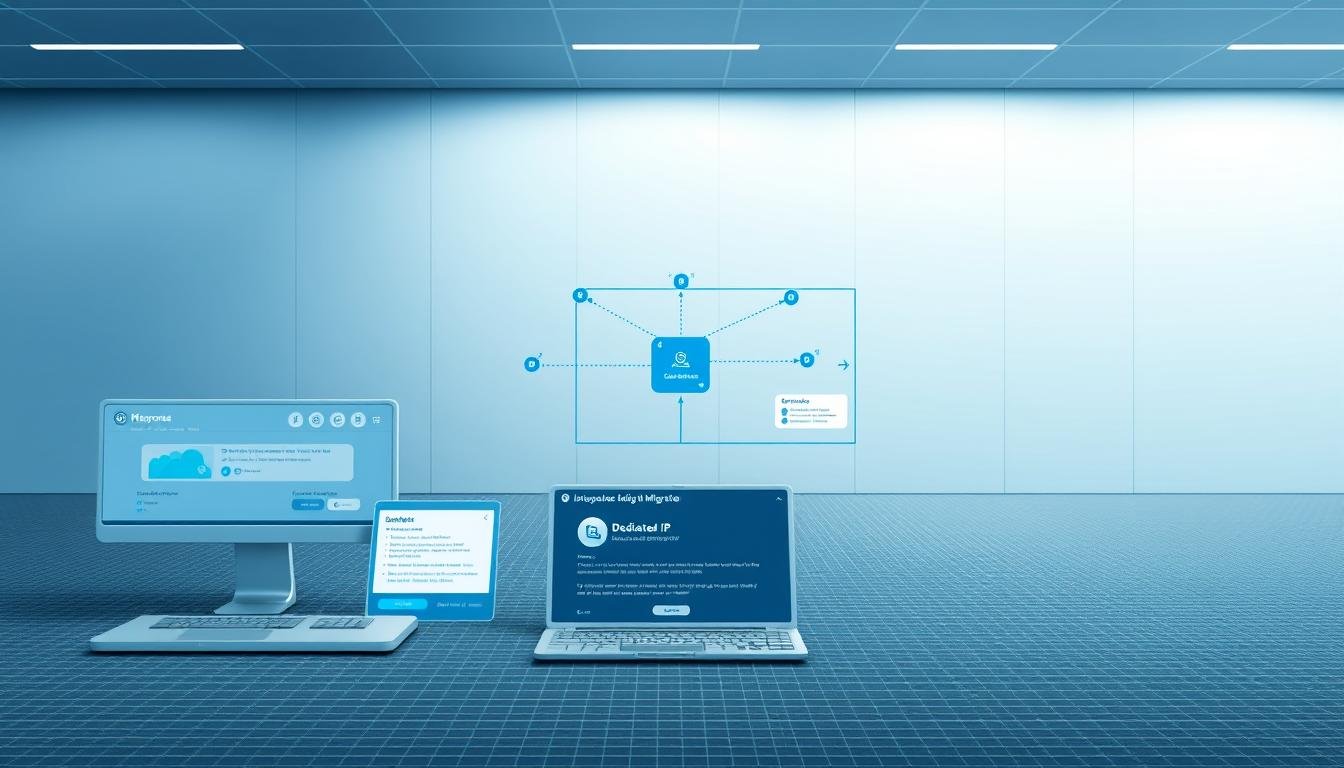This concise guide shows you how to move to a private sending address and warm it safely so your email reaches inboxes. You’ll map a clear process from audit to daily warmup, protecting your sender reputation and marketing revenue.
You’ll prepare your account, lists, templates, and tracking to reduce risk during the change. The goal is steady deliverability gains and measurable results over time.
New sending resources start with no history, so you must build trust with providers. Assisted IP Warmup tools can pace volume and spill excess through a high-quality shared pool until your reputation is established.
By following a repeatable framework, you control cadence by ISP, monitor complaints and bounces, and keep stakeholders aligned for a smooth handover to a new esp. This approach minimizes downtime and speeds meaningful results.
Key Takeaways
- Plan the entire process: audit, prep, warmup, monitor.
- Isolate sender reputation to improve deliverability and outcomes.
- Use pacing and ISP splits to build trust methodically.
- Track clicks, complaints, and hard bounces daily.
- Configure authentication so messages pass ISP checks.
- Leverage assisted warmup to accelerate safe growth.
Why migrate to a dedicated IP with GetResponse right now
Switching to a private sending address puts you in charge of reputation, branding, and speed to send. That control matters when deliverability is uneven and inbox placement drifts.
Start the warmup and authentication process now to reduce issues before peak campaigns. Proper SPF, DKIM, and DMARC setup plus feedback loops help your deliverability stabilize in less time.
- Regain control: If you face deliverability issues, a private route is a proven way to improve inbox outcomes.
- Brand trust: Your emails and tracking reflect your domain, which builds confidence with subscribers and protects lists.
- Predictable performance: You avoid pooled noise from other senders and can scale time-sensitive campaigns without shared queues.
- Supported transition: GetResponse offers onboarding so your email service provider change follows a clear process.
Dedicated vs shared IPs for email deliverability and sender reputation
How you host outbound addresses determines whether your reputation is shared or fully under your control. That choice shapes inbox timing, recovery risk, and how providers judge your messages.
Key benefits of an exclusive sending resource include control over your sender reputation, faster time to inbox, and consistent branding for your domain and tracking links.
- Full ownership: you alone shape reputation through list quality and sending patterns.
- No shared queues: messages leave immediately, preserving timing for campaigns and transactional mail.
- Clear diagnostics: problems map back to your data and segments, so you fix issues faster.
Shared pool risks come from pooled reputation. One bad actor can spike complaints or trigger spam filters and drag everyone down. Service providers use dynamic filtering and blocklists that can hit pooled addresses without warning.
When to choose exclusive vs shared: stay shared if your list is small or you send very infrequently. Move to an exclusive resource when you send consistent, higher-volume campaigns and need tighter control of deliverability and brand signals.
Pre-migration prep: audit data, compliance, and migration timeline
Start by taking a full inventory of your email assets so the transfer runs without surprises. Export subscriber lists (CSV), custom fields, tags, templates, automations, and campaign history. Keep secure backups and archived campaign reports for at least one business cycle.
Clean data before you import. Remove invalid, duplicate, or stale addresses and verify opt-in permissions to reduce early bounces and complaints. Make sure suppression lists and unsubscribe states migrate accurately to honor consent and limit regulatory risk.
- Inventory assets: lists, tags, fields, templates, automations, and performance history—export and store safely.
- List hygiene: remove bad or inactive subscribers and confirm permissions to protect sender reputation.
- Data mapping: document field and segment mappings so imports align 1:1 and reporting remains comparable.
- Stakeholder plan: align marketing, CRM, and ops on timing, roles, QA, and a zero-downtime schedule.
Decide which campaigns pause and which validate the new service with test sends. Establish restoration points and rollbacks so you can recover quickly if issues appear. Build extra time into the timeline for template QA, data checks, and warmup staging to minimize rework.
Technical setup in GetResponse: domains, authentication, and infrastructure

Begin by verifying DNS records and account settings so authentication and tracking work from day one.
Configure SPF, DKIM, and DMARC for your sending domain and any subdomains used for tracking or transactional mail. Publish each record and validate them with the testing tools in your account. Proper records help ISPs trust your messages and improve inboxes placement.
Feedback loops and reputation monitoring
Enable feedback loops with major providers so complaint signals trigger automatic suppression. Pair FBLs with reputation monitoring to catch spikes in complaints or bounces early. This protects your sender reputation as you scale sending volumes.
Sender profiles, branded links, and integrations
Create sender profiles that align the From name, reply addresses, and handling rules with your brand. Brand tracking links and URLs to your domain to reduce filter suspicion and increase clicks.
Reconnect CRM and ecommerce integrations and validate data flows both ways.
- Confirm field mappings, consent flags, and custom objects so automations behave as designed.
- Test rendering across clients and devices and fix CSS or image-hosting issues before ramping volume.
- Run a live seed test to confirm authentication alignment and campaign attribution.
In your account, make sure dedicated assignment, sending throttles, and per-ISP limits are set for warmup. These checks reduce surprises and keep your campaigns on track.
getresponse dedicated ip migration steps: warmup strategy and sending plan
Start warmup by sending very small, predictable volumes to your most engaged recipients. New MAX IPs have no history, so internet service providers expect gradual, consistent activity.
Use an ISP-split warmup whenever possible. Send very low counts to Gmail first and ramp daily by ISP. Microsoft, Yahoo, and regional providers each accept different early thresholds, so pace per provider.
ISP-split warmup: daily cadence, Gmail caution, and engaged cohorts
Begin with your top-engaged cohorts to maximize positive engagement signals. Keep a daily cadence and avoid pauses; consistent time-based sends build reputation faster than spikes.
Simplified schedule and transition period
If you can’t split by ISP, follow a conservative simplified schedule and monitor metrics closely. Be ready to slow the ramp if any provider returns poor signals.
- Transition: If you keep the same sending domain, run a 1–2 week overlap: ~90% old From / 10% new, then reverse.
- Content: Send lean, highly relevant emails during warmup; skip heavy promotions and large templates.
- Tracking: Monitor opens, clicks, bounces, and complaints daily and adjust volume per ISP.
Document results by ISP and refine the plan in real time. Small, steady increases protect deliverability and build lasting reputation for your new esp.
Segmenting audiences and crafting messages that improve inbox placement

Start by grouping your most active recipients to build reliable engagement signals from day one. Target clickers first, since clicks give a stronger signal than opens and resist Apple’s MPP noise.
Engagement-first segmentation by clicks, recency, and ISP domains
Prioritize recent clickers and then add recent openers. Segment by ISP domains—Gmail, Yahoo/AOL, Microsoft, and others—so you can pace volume per provider and troubleshoot fast.
Safe content construction: balanced links, relevant offers, and CTAs
Keep emails concise. Use a healthy text-to-image ratio and limit links to one or two per message. Clear CTAs that invite replies boost engagement and warmup performance.
- Use proven marketing content: repurpose top-performing messages to lift early engagement.
- Expand by recency tiers: add newer subscribers before older segments to protect reputation.
- Consistent branding: keep From address, display name, and footer stable so subscribers recognize you.
| Segment | Priority | Message focus |
|---|---|---|
| Recent clickers | High | Short, action-driven offers; invite replies |
| Recent openers (no clicks) | Medium | Engaging subject lines; one clear CTA |
| Older subscribers | Low | Re-engagement series only after solid warmup |
Monitoring, troubleshooting, and pacing during warmup
Track clicks and complaints every day to spot problems early and act fast. Clicks are your primary success signal; opens are directional because modern privacy changes inflate them. Watch complaint rates closely—aim for
Read bounce logs each day and classify failures. Hard bounces near 0% early are the goal; a sustained >2–3% points to data or consent issues. Some temporary blocks and spam placement are normal; dragging affected messages from the spam folder into the inbox can help retrain filters.
When you see issues, reduce or reallocate volume by ISP rather than stopping all sends. Maintain a daily cadence—pauses often hurt momentum more than low-volume continuation.
- Track clicks as the top indicator; use opens as secondary insight.
- Keep complaints low and hard bounces near zero; investigate spikes fast.
- Adjust per-ISP pacing based on results; document every corrective action at the account level.
- Review content: links, image ratio, and CTA simplicity if spam placement rises.
Document patterns and fixes so your team repeats what works and avoids dead ends. Treat anomalies as learning moments; the right data reveals which factors to tune for better deliverability and long-term sender reputation.
Partnering with GetResponse MAX for assisted warmup and expert support
A white-glove service pairs your team with experts who manage thresholds and spillover during warmup. Your account gets an Account Manager plus a Deliverability Team that watches performance and advises changes in real time.
Assisted IP warmup sets a sending threshold on your new address and routes any excess through a vetted shared pool. That spillover keeps campaigns flowing while your sender reputation builds.
- Hands-on coordination: your Account Manager aligns cadence, authentication, and testing with the deliverability team.
- Risk control: thresholding prevents sudden volume spikes that trigger blocks from providers.
- Stream separation: run transactional mail on a separate domain/subdomain and sending stream from marketing to protect critical messages.
| Support | Role | Benefit |
|---|---|---|
| Account Manager | Coordinate strategy | Faster decisions, aligned account activity |
| Deliverability Team | Troubleshoot ISP issues | Improved inbox placement and faster fixes |
| Assisted Warmup | Threshold + spillover | Safe volume growth without lost revenue |
Conclusion
A disciplined warmup with authenticated domains and ISP feedback loops improves deliverability and helps your messages land in inboxes predictably. Keep sends small, consistent, and focused on highly engaged recipients while you build reputation on the new sending domain.
Use a 1–2 week overlap when retaining your From address, monitor per-ISP thresholds, and compare key metrics to measure progress. This way you start sending new volumes without risking large drops in placement.
Lock in results with strict data hygiene, simple content, and per-ISP pacing. Use assisted warmup and account support to shorten stabilization time and protect your account as your list and addresses grow.
Outcome: a repeatable framework that raises your email marketing to the next level and keeps campaigns reaching inboxes at scale.

